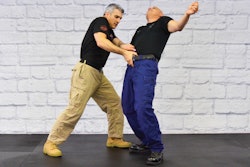![[|CREDIT|]](https://img.policemag.com/files/base/bobit/publicsafety/image/2020/07/pm.we-1.png?auto=format%2Ccompress&fit=max&q=70&w=400)
In the March issue of POLICE, I discussed Police Krav Maga techniques for disarming a subject with a weapon in his or her front waistband. (See "Front Waistband Disarming with Police Krav Maga.") So this article on how to react to a weapon in the suspect's rear waistband is the natural follow-up.
Research from the Federal Law Enforcement Training Center (FLETC) shows that a perpetrator can deploy a handgun from his waistband in as little as one-third of a second while the average officer's reaction time to counter-draw a weapon is between two and four seconds. Collective studies by the NYPD, FBI and California POST underscore that over 50% of all officers are shot are within a potential disarm range of five feet. That means officers need to have a faster instinctive unarmed response option for such close-up encounters.
Police Krav Maga provides for an important defensive tactics multiplier effect. It gives officers a few core techniques that can handle a variety of threats and be applied for multiple purposes.
Let's examine an example of how Police Krav Maga can be used to disarm a suspect before he can deploy a sequestered firearm from his rear waistband.
In this scenario, a suspect is within close proximity to you as the confronting officer. Your sidearm is holstered. You do not expect a deadly force situation. But the suspect has other ideas.
The suspect unexpectedly reaches for a handgun in the rear of his waistband. As action beats reaction, the perpetrator is likely to outdraw you. You can counter this threat without trying to outdraw your attacker.
As you recognize the threat, instantaneously take a diagonal left step to close on him so that you can control his weapon reach arm. As you close on him, knee him in the groin—a justified use of force in a deadly force encounter.
To properly time any disarming technique you must understand "time in motion"—both yours and his—or how a body instinctively reacts to a stimulus. As you close the distance to the gunman, try to cant your body to the suspect's right side off the threat line (similar to all sound defensive tactics), not directly in front of him.
As you simultaneously close on the suspect to deliver your right knee strike, secure his right reaching arm just above his wrist with your left arm. Immediately, cinch your grip to create a strong vise grip on his gun arm. Wrench his shoulder forward and up to assert dominant control.
Note: If you miss grabbing his reach arm, by design you are still in position to jam and control his shoulder with your torso to prevent him deploying a weapon against you. This is also why the combined Police Krav Maga's bedrock principle of defense and distract/attack is so important: you must distract (and debilitate in a deadly force encounter) him as soon as possible to gain control.
With your right arm as you close and knee him, you may also slam him simultaneously in his carotid or simply secure him by the shoulder. When you deliver the powerful knee strike, it will usually drop his level. As you gain control of his arm, slam the top of your right forearm (radial bone) into the crook of the assailant's right elbow to fold it forcefully inward to facilitate a control often known as a kimura hold. Stab your right arm through the opening between his right arm and his torso to cinch the shoulder lock. Keep the assailant's right arm decisively pinned against your torso to firmly control it. Prepare to take him down to the ground. (Note: Another defensive option is to kick the would-be assailant in the groin and then close on him, however, this type of kick with its associated footwork requires extensive training.)
While asserting dominant control, forcefully drive the assailant to the ground at your two o'clock (not your twelve o'clock as he might try to roll on you). As you take down the assailant, be sure to keep his torso close to your torso to prevent any attempt to roll away from you as you drive him to the ground.
As he drops down, drop with him landing your left knee astride his bent elbow and your right knee on his head. Place the majority of your body weight on him to control him by staying on the balls of your feet. (Note: For a non-deadly force situation, your knee would not be placed on his head, but on his shoulder blade allowing normal respiratory function.)
To remove the weapon, keep his left arm pinned with your left arm. With your right hand, secure the barrel to wrench the weapon down and away. Secure the weapon or use it as necessary.
This Police Krav Maga move can be modified for other situations.
It can be modified to control a suspect when an officer is facing him from the twelve to four o'clock positions and needs to control the suspect, even if the suspect is not drawing a weapon.
For objectively reasonable force, if he is not reaching for a concealed weapon, the distraction element of the strike to the groin would be modified. Rather than a distraction knee strike to the groin, a knee strike to the thigh or a kick to the shin. This controlled descent provides for objectively reasonable force as you drive him to the ground because he has one arm free to break his fall.
On a personal note and as a grateful civilian, now more than ever, I thank each and every officer who serves. Each officer can never receive enough gratitude and support for putting everything on the line every day.
David Kahn serves as US Chief Instructor for the Israeli Krav Maga Association (Gidon System). Kahn runs Police Krav Maga instructor certification programs throughout North America. De-escalation tactics, use-of-force considerations, and liability mitigation are integral to the training. He can be contacted at david@israelikrav.com.














